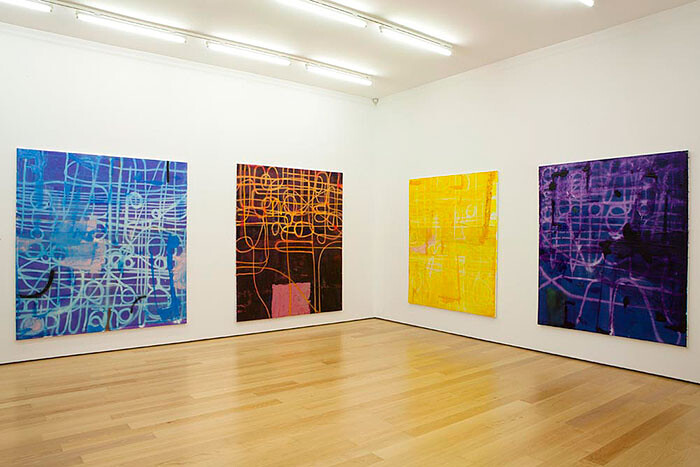In “The Basement of Alamo,” Alex Hubbard transforms the Eleni Koroneou gallery into a laboratory of zymosis. For his first solo exhibition in Athens, the artist has presented a new series of seven paintings, all made in 2011, which rely on a dynamic juxtaposition of different materials and applications. Employing acrylic, resin, and fiberglass, the paintings heed to a dramatic clashing of form and color that results in a radical polyphony. Part-print, part-painting, these images become part of a nameless genre: although bearing traits of abstract expressionism, the aesthetic of any “accepted” visual art trend is clearly nullified. Fluid forms merge together in a choreography of the senses. A gestural painterly drip is posited in contrast to the flatness of the printing process, alluding to a certain kind of emotional indecisiveness between the accepted and the unexpected, the solid and the instinctual.
Arthur Danto describes modernist art as an art defined by taste and made essentially for people with taste, while he discusses the end of modernism as the exodus from the tyranny of taste and the welcoming of the anti-formal and the anti-aesthetic. And this seems, in a way, quiet true. Yet Abstract Expressionism—as other exemplary movements—was more discussed as an aesthetically innovative practice rather than a sociopolitical and existential revolutionary gesture. All these efforts encompassed and furthered—albeit through a codified set of mannerisms and imitations—the most basic human need: the emancipation from any kind of absurdly oppressive regime. At first sight, the works here might come across like an exercise in abstraction, or even an exercise in expression, seeking out a position in the present. Known mostly for his performative video works, Hubbard seems quite uncomfortable with the conventions of the painting system—or so one presumes. Even if one might mistake their intention by thinking that they attempt to advance the “steps” of modern painting, they rather seem more like sharp comments to the rigidity in the perception of Painting as a condition. These are paintings about the codification of Painting, where notions of disbelief, ferocity, finality, and humor are vital elements of the composition. In an effort to create the right painting (and by that I mean a timely one) Hubbard undoes our acquired knowledge and taste. These works look like the once-respectable relics of paintings that have been taken apart. This very fact—and the process of its manifestation—seems to be their most urgent and contemporary quality. What appears “detached” and “nonsensical” in art historical terms might be in tune with what is happening in society today. In other words, by using the most classical visual code, Hubbard seeks to reflect on it.
“Really, I never set out to destroy something. As a kid, I often used the excuse of taking something apart to see how it worked or what was inside, and that never felt like a purposeful destruction. Now, the excuse would be an exploration of materials,” said the artist in a recent interview. Landscapes of destruction, in which diverse “violations” are taking place, these paintings reflect on the everyday reality of the city. As this is being written, over a hundred thousand protestors have gathered together in the center of Athens. The march resulted in a massive demolition of Syntagma Square and its surroundings, and it is continuing…. Tomorrow maybe Athens will be an abstraction of the city as we know it. In parallel to the rhythm of the city, Hubbard has destructed the given order while bringing to the surface the vanity in any form of destruction.




